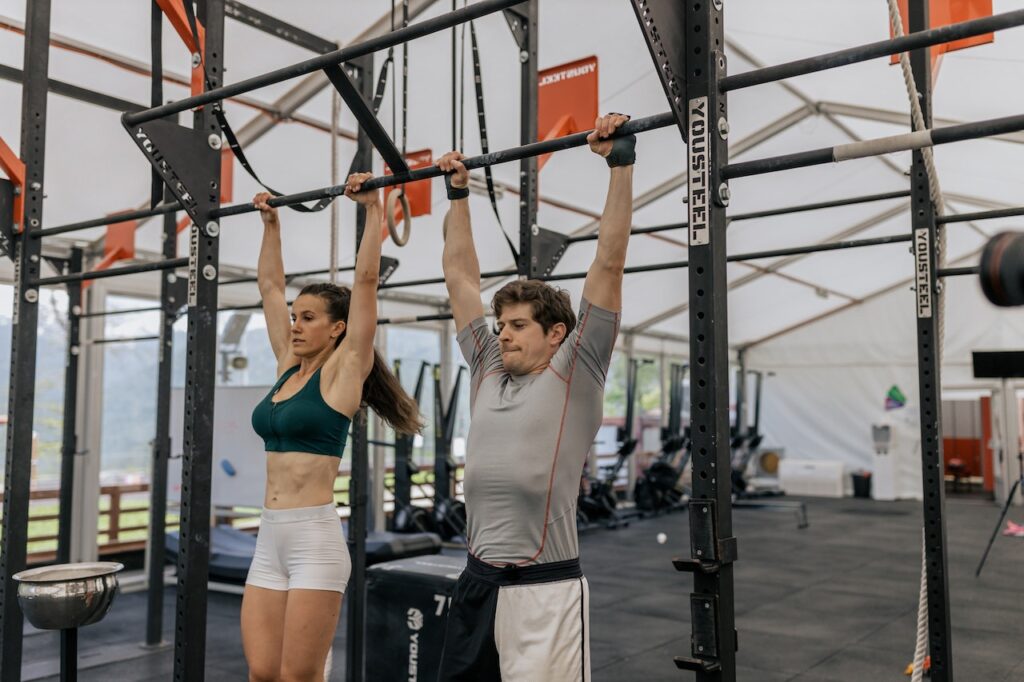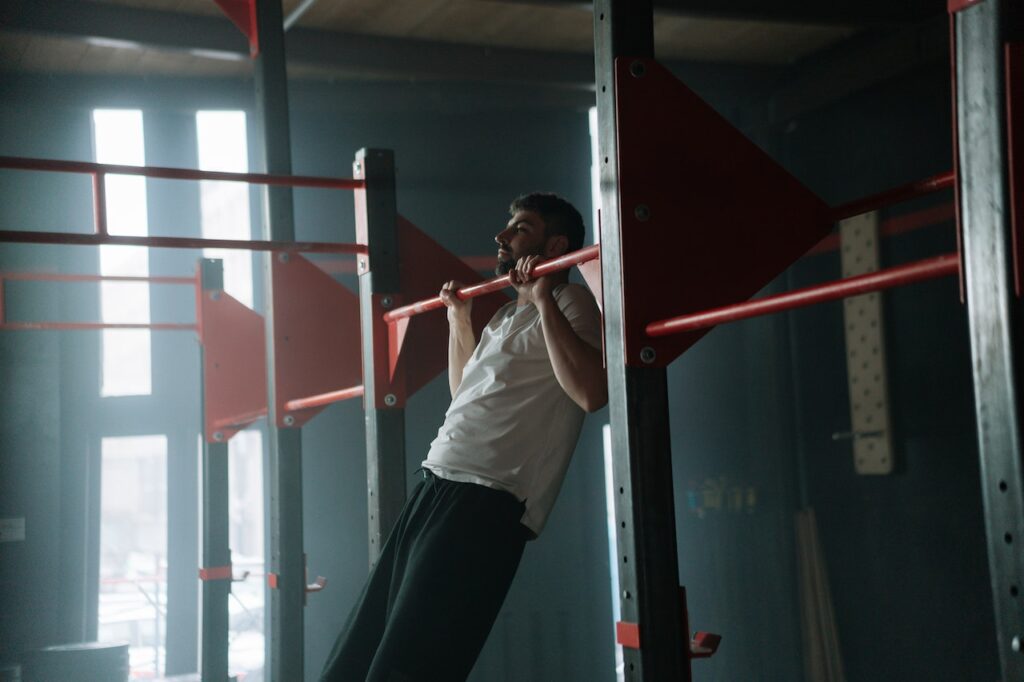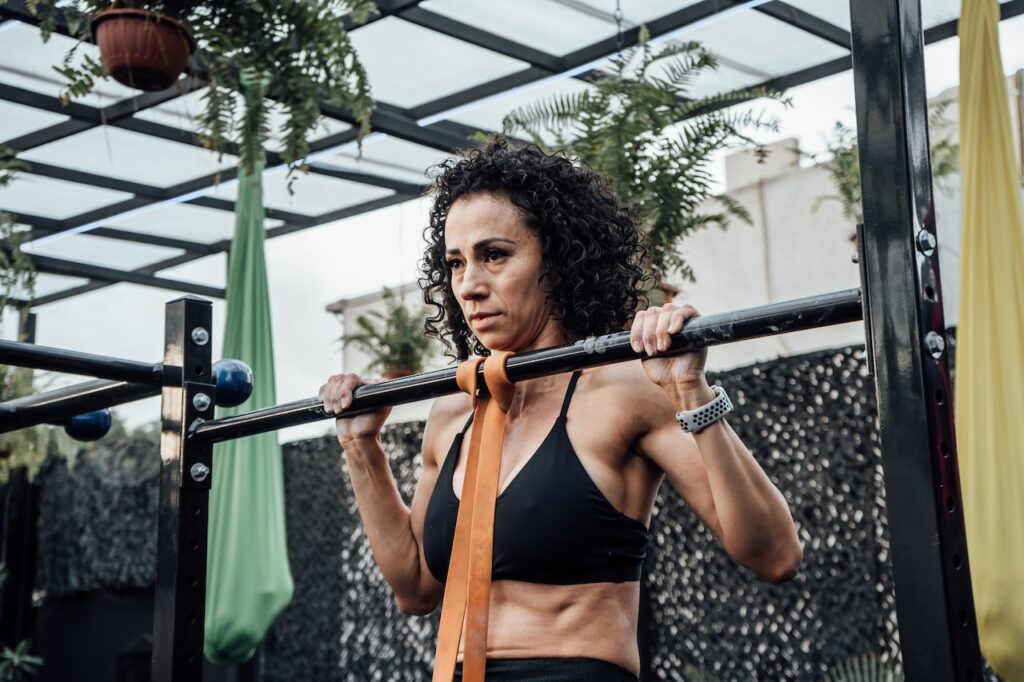Performing pull-ups can be intimidating, especially for people who have yet to try them. However, you can try different pull-up variations to help build up to your first pull-up. So whether you are a novice or an expert in doing pull-ups, here are some of the best pull-up variations for all fitness levels.
Best Pull-Up Variations – Beginners
These beginner pull-up variations will train you to have good form and help you develop the strength you need to crush any version of this workout.
| Pull-up Variations – Beginners | Muscles Worked |
| Bent Knee Inverted Row | Back Shoulder, Glutes, Hamstrings, Inner Bicep, Inner Forearm, Lats, Lower back, Outer Bicep, Outer Forearm, Quads, Upper Back |
| Straight Leg Inverted | Latissimus Dorsi, Upper Back, Biceps, Forearms, Core |
| Dead Hang | Forearms, Hand and wrist flexors, Trapezius, Latissimus dorsi, Anterior deltoids, Posterior Deltoids, Abdominals |
| Jumping Pull-Up | Quadriceps, Hamstrings, Glutes, Calves, Forearms Biceps, Latissimus Dorsi, Abdominals, Obliques, Spinal erectors |
| Eccentric Pull-Up | Latissimus dorsi, Trapezius, Deltoids, Pectoral, Biceps, Forearms, Triceps |
Bent-knee Inverted Row
Bent-knee inverted row is very advantageous for newbies who are still trying to build up their pull-ups. However, they are also beneficial for lifters of any fitness level. This exercise is great for increasing upper body strength and building back muscles.
How to Do it
- Place yourself under the bar and grab the bar with an overhand grip. Position your feet out in front of you and bend your knees so that your thighs are parallel to the floor.
- Exhale and pull yourself towards the bar while extending your knees to help you.
- Carry on until your chest can no longer get nearer to the bar.
- Inhale and drop your body to return to the starting position with your arms completely stretched.
Straight Leg Inverted
Straightening your legs while performing an inverted row brings balance which recruits more stabilizers throughout your upper body.
How to Do it
- Place yourself under a fixed horizontal bar and grab it with a wide overhand grip.
- Make sure your legs are straight with your heels on the floor; the bar should align with your chest.
- Keep your arms straight while engaging your core and raise your hips.
- Drive your chest up to the pull-up bar.
- Drop your body to return to the starting position with your arms completely stretched.

Dead Hang
Dead hang is another way to achieve a pull-up. It may seem that you are doing nothing with a dead hang because you are just simply hanging from a bar and not exactly pulling your body up. However, this exercise can help improve grip strength and endurance and positional strength.
How to Do it
- Use a bench or a chair to reach the bar. Do not go straight into a dead hang.
- Put your hands on the pull-up bar with palms facing away from you. Make sure that you are grabbing the bar with your arms shoulder-width apart.
- Move your feet away from the bench to hang onto the bar.
- Keep your arms extended and straight, and do not bend your arms.
- Hang for ten seconds if you are a beginner to this exercise as you work your way up to forty-five seconds to a minute at a time.
- Then step back on the bench or chair before freeing your arms from the bar.
Jumping Pull-up
This is a vigorous total body exercise incorporating a big amount of muscle tissue to implement correctly. Jumping pull-up builds up trunk stability and strength. It generates power transfer from the lower body to the upper body.
How to Do it
- Set your bar so that it is slightly above head height.
- Put your hands on the pull-up bar with a wide overhand grip. Stand about hip to shoulder wide and engage your abs. Draw your shoulders down and back.
- Bend your legs till your arms are completely straight while holding the bar.
- Stretch your legs and jump up while pulling with your arms.
- Control your drop by decelerating with your back and arms.
- Come down as lightly as you can and release the bar, or you can hold it to transition into another repetition.
Eccentric Pull-Up
An eccentric pull-up is a good exercise if you can only complete a partial pull-up. This workout is a good way to build eccentric strength that will greatly develop your back muscles and grip strength.
How to Do it
- Stand underneath a bar and on top of a box.
- Put your hands on the pull-up bar with an overhand grip.
- Make sure that you engage your core, squeeze your glutes and tuck the tailbone when you jump off the box.
- Avoid swinging by keeping your torso stable, and slowly drop by stretching your elbows till your arms are straight.
- Pause.
- As you keep your composure, make your arms straight and manage your torso when you descend.
- When building your strength, add concentric reps to the beginning of the workout until you can do a complete pull-up.
Pull-up Variations – Intermediate
If the above pull-up variations are too easy for you, then you have got to try these mid-level pull-up variations.
| Pull-Up Variations – Intermediate | Muscles Worked |
| Chest-to-Bar Pull-Up | Biceps, Rhomboids, Trapezius, Latissimus Dorsi, Obliques |
| Kipping Pull-Up | Wide shoulders, Lats, Grip, Abdominals, Latissimus dorsi, Arms, Legs, Upper Back |
| Isometric Pull-Up | Lats, Triceps, Middle Back, Traps, Shoulders, Rhomboids and Forearms |
| Chin-Up | Biceps brachii, Brachialis, Brachioradialis, Latissimus dorsi, Teres major, Posterior deltoid Deeps spinal stabilizers, including the Transverse abdominis, Lumbar multifidus and Thoracolumbar fascia |
| Band-Assisted Pull-Up | Core, Shoulders, Back and Arms, particularly the Biceps, Lats, and Forearms, Pecs, Traps, Erector External oblique, and spinae |

Chest-to-Bar Pull-Up
The chest-to-bar pull-up is a very effective upper body workout. It is a multi-joint exercise that evenly works all your upper back muscles.
How to Do it
- Place your hands on the bar with a wide overhand grip. You can put your thumbs around the bar, or you can use a thumbless grip.
- Hang from the pull-up bar with your body and arms straight.
- Draw your shoulders down and back as you press your arms onward against the pull-up bar to drive your body backwards.
- Push your elbows down and back, and drag yourself up towards the pull-up bar.
- Draw up till the bar touches your chest.
- Move down under control and repeat.
Kipping Pull-Up
This pull-up variation is known to build endurance more than strength. It is also one of the most complete full-body exercises that you can add to your fitness routine.
How to Do it
- Begin by hopping on the pull-up bar, then swing with your shoulders. This will help you to switch between hollow or arched positions. Engage your core while swinging your body.
- After three to four swings come the hip pop move. Your momentum plays a significant role, where you will pop your hips open while you draw your body toward the pull-up bar.
- When you get your chin above the pull-up bar, draw your body back and away into a hollow position. Then push your chest out again to launch the momentum for another repetition.
Isometric Pull-up
This exercise is a great way to learn to engage your back muscles in your pull-ups. It strengthens your lower traps and rhomboids, which help in supporting the posture that prevents you from the risk of a shoulder injury.
How to Do it
- Hold onto the bar with your hands wider than your shoulder.
- Lift your body up and make sure that your chin is over the bar.
- Hold that position for the desired time before you let yourself down.
Chin-up
Chin-ups are almost the same as pull-ups; the only major difference is that they use a supinated grip instead of a pronated pull-up grip. Using a supinated grip is great for developing bicep strength and growth without relying on curls.
How to Do it
- Place your hands on the bar using a supinated grip.
- Recruit your legs and core to avoid swinging. If you can’t control the swing, you can keep your feet in front of you or cross them behind.
- Draw your shoulders in place by clasping your shoulders together and downward.
- Push your chest to the bar and rise as high as you can. Do not shrug your shoulders or lift your chin to the bar.
- Go back to starting position and do it again for the desired repetitions.
Band-assisted Pull-up
Band-assisted pull-ups can help you increase muscle strength and help you prepare for total bodyweight pull-ups.
How to Do it
- Attach a band to the bar.
- Place one foot inside the resistance band and grab the bar in an overhand grip.
- Extend your legs as you press the band and bring your chin over the bar.
- Descend your body till your arms are fully stretched.
Pull-up Variations – Advanced
You do not need to tire yourself with endless repetitions to overwork your pull-ups progressively. Instead, try these more advanced variations to make your pull-up routine more challenging.
| Pull-Up Variations – Advanced | Muscles Worked |
| One-Arm Pull-Ups | Biceps, Triceps, Core, and Dorsal muscles |
| Archer Pull-Ups | Upper body muscles, Lower body muscles, Arms muscles, Biceps, Forearms, Lats, Middle back, Shoulders, And Trapezius |
| Frenchies | Large muscles on back and arms |
| Typewriter Pull-Ups | Lats, Biceps, Rotators, Deltoids, Scapular muscles and other muscles in the Shoulders, Back, Chest and Arms |
| L-Sit Pull-Ups | Core strength, Hamstring, Hip flexibility, Legs, Abdominals, Hip flexors, Transverse abdominals, Obliques |
One-arm Pull-ups
This workout is probably the most extreme test of your strength. The one-arm pull-up is one of the best ways to build biceps and upper back strength through bodyweight training.
How to Do it
- Grip the bar with one hand.
- Place your other arm on the wrist of your lifting arm.
- Try to swing your other arm instead of holding your wrist to give your body momentum to make your first rep much easier.
- Lift your body off the floor until your head is over the bar. Ensure that your chin won’t hit the bar when you descend. You can bend your legs and cross your ankles to keep your body stable.
- Do as many as you can.
Archer Pull-ups
This workout looks like an archer shooting a bow and arrow, hence the name. It is one of the best callisthenics bodyweight training workouts when performed with proper form.
How to Do it
- Place your hands on the bar with a wide overhand grip.
- Start the workout by driving yourself up and to the left. Ensure that your right arm is horizontal with the floor at the peak of the pull-up.
- Descend your body back and repeat with the opposite arm.

Frenchies
This a very popular exercise for climbers because it adds isometric contraction to the pull-up, making it an excellent workout for endurance.
How to Do it
- Pull your chin above the bar for 5 seconds.
- Perform another pull-up, but this time you need to descend one-quarter of the way down.
- Pause for 5 seconds and repeat. Make sure you stop and hold slightly lower than the last time.
Typewriter Pull-ups
The typewriter pull-up moves the body back and forward along the bar, which resonates with the movement of a typewriter, where it gets its name. This is a very difficult exercise to master, so you must be able to do the correct pull-up form before attempting to try this technique.
How to Do it
- Grip the bar in a wide overhand.
- Pull the body upwards towards the right side. Control your swing by tightening your core.
- Push down on the bar with your left hand and uncurl your left arm. Your left wrist and forearm should be on the of the bar.
- Drive your torso across to the left side as you hold the bar with your left hand.
- Drive down on the bar with your right hand, then uncurl your right arm just like you did with your left arm. Your right wrist and forearm should be above the bar.
- Repeat the manoeuvre for the desired reps.
L-sit Pull-ups
This workout will surely blast your core. It is a very challenging workout that will challenge your core, especially your lower abs.
How to Do it
- Put your hands over the bar using an overhand grip.
- Move your shoulders back and drive your chest out. Bend your hips and lift your legs until they are parallel to the floor. Your body should resemble an L shape. This is your starting position.
- Exhale and lift your body by driving your upper arms and shoulders down and back. Squeeze your back when you are at the peak of your pull-up.
- Maintain the contracted position for one second. Then inhale and descend your body back to the starting position where your arms are completely stretched. Do not simply bring your body back down.
3 Benefits of Pull-ups
Here are some reasons you should incorporate pull-ups into your fitness routine.
1. Strengthen the Arm, Back and Shoulder Muscles
Pull-ups are the most effective back-strengthening workouts you can try. They strengthen your latissimus dorsi, levator scapulae, trapezius, erector spinae in the thoracic region, and infraspinatus. Pull-ups can also strengthen and sculpt your arms, shoulders and core.
2. Enhances Grip Strength
Having grip strength is very useful in doing your everyday tasks. Simple tasks like opening a jar need grip strength. Performing pull-ups is one of the best workouts that can help strengthen your grip and hands.
3. Improve Overall Fitness and Physical Strength
When you are doing pull-ups, you are lifting your whole body mass. This exercise can greatly increase your overall fitness level and improve physical strength.
Final Thoughts
Pull-ups are very challenging, but they are an excellent addition to your strength training routine. Whether you are new or an expert on pull-ups, you can try different pull-up variations to develop your pull-up form, or you can do more advanced variations to challenge your strength more.
Related Questions
1. Will pull-ups make me bigger?
After some time, regular pull-ups can increase your muscle size, as long as you get adequate protein intake and eat at a calorie surplus.
2. What are pull-ups good for?
Pull-ups are good for strengthening your arms, back, and shoulder muscles and enhancing grip strength.
3. What are the best pull-up bars for home use?
You can learn about the best pull-up bars for home use here.
- How Long Should You Stay in a Sauna Safely? - 20 January 2024
- Boost Post-Workout Recovery: Benefits of Using a Sauna for Recovery - 19 January 2024
- Discover the Health Benefits of a Low EMF Infrared Sauna - 19 January 2024
